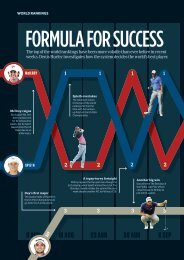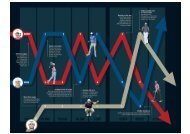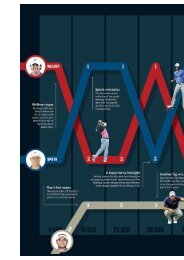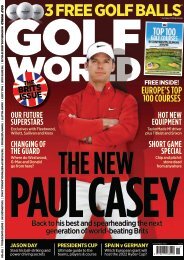You also want an ePaper? Increase the reach of your titles
YUMPU automatically turns print PDFs into web optimized ePapers that Google loves.
TODAY’S GOLFER AUGUST 2015 (JULY 9-AUGUST 5) 337<br />
<strong>BEAT</strong> <strong>YOUR</strong> <strong>BOGEY</strong> <strong>HOLE</strong> <strong>WIN</strong> <strong>FOOTJOY</strong> <strong>SHOES</strong><br />
EXCLUSIVE<br />
Tom Watson...<br />
quizzed by you<br />
Plus: The eight-time major<br />
champ shares his best tips<br />
WWW.TODAYSGOLFER.CO.UK<br />
AUGUST 2015 ISSUE 337 JULY 9-AUGUST 5 £4.50<br />
DRAIN IT<br />
LIKE JORDAN!<br />
Why YOU need a<br />
fat putter grip<br />
How to read it, stroke it... and knock it in
The star<br />
factory<br />
Inside the coaching school that’s<br />
turning England’s promising young<br />
golfers into multiple tour winners<br />
WORDS ROB Mc GARR PICTURES ANGUS MURRAY, GETTY IMAGES<br />
Andy<br />
Sullivan<br />
Two European Tour<br />
wins already in<br />
2015.<br />
Eddie<br />
Pepperell<br />
Challenge Tour<br />
winner and Top-100<br />
golfer, making his<br />
Open debut this<br />
year.<br />
Danny<br />
Willett<br />
Two-time European<br />
Tour winner, ranked<br />
36th in the world.
Chris Wood<br />
Two European Tour<br />
wins. Finished 5th<br />
as an amateur in<br />
2008 Open, tiedthird<br />
a year later.<br />
he top-20 at this year’s Irish Open<br />
featured Danny Willett, Andy Sullivan,<br />
T<br />
Chris Wood, Eddie Pepperell, Matt<br />
Fitzpatrick and Tyrrell Hatton. Those players all<br />
have two things in common. One – they’re all<br />
English, part of a vanguard of new,<br />
homegrown stars who are taking over the<br />
mantle from the likes of Lee Westwood and<br />
Luke Donald. And two – they all benefited<br />
from England Golf coaching on their pathway<br />
from young prospect to Tour professional.<br />
The most notice the majority of amateur<br />
golfers will pay to England Golf is the small<br />
affiliation fee – usually around two per cent –<br />
added to your annual membership fee. This<br />
money goes towards things like organising<br />
your county championship and administering<br />
the handicap system. But England Golf also<br />
uses it, along with some National Lottery<br />
funding, to provide coaching to talented<br />
youngsters and turn them into future Tour<br />
pros and, with a little luck, the first English<br />
Major winner since Nick Faldo won the<br />
Masters in 1996.<br />
Wood, who recently won his second<br />
European Tour title, says: “Obviously we did a<br />
lot of work on our game, but there was also<br />
off-the-course training plus lots of travelling<br />
which educated us on what was needed and<br />
how to be strong enough for life on tour when<br />
we turned pro.<br />
“The sort of opportunities I had to play<br />
around the world just wouldn’t have been<br />
available if I hadn’t broken into the English<br />
teams and got that support. When you<br />
understand how important being in the<br />
England set-up was you can appreciate how<br />
desperate I was to get in it.”<br />
“National coaching really took off in 2001,”<br />
says Stephen Burnett, performance manager<br />
for England Golf. “There were obviously still<br />
English golfers doing well before then, but it’s<br />
a completely different world out there now<br />
with all the other countries really investing in<br />
golf coaching.”<br />
In a world where sport is big business and<br />
one home-grown Major winner can change<br />
the future of a sport, England cannot afford to<br />
rely on chance to deliver world-beaters when<br />
other countries are investing millions in<br />
spotting and nurturing young talent.<br />
“There aren’t many golfers that have<br />
gone on to the Tour in the last few<br />
years that haven’t come through the<br />
programme in some respect,”<br />
says Burnett.<br />
Nowadays, a structured<br />
programme invites<br />
applications from<br />
promising teenagers,<br />
the best of whom are<br />
invited to attend a ➔
SHORT GAME<br />
Take the fear<br />
out of chipping<br />
WGC MatchPlay semifinalist<br />
Danny Willett<br />
helps you strike chips<br />
with more conviction<br />
Fault: Golf is full of myths about<br />
technique, often passed on to<br />
amateurs from playing partners.<br />
Golfers are strangely keen to listen<br />
to the advice of people who aren’t<br />
really qualified to give it. As if any<br />
of us would let someone have a go<br />
at repairing our car, just because<br />
they drive one themselves.<br />
Fix: This acceptance of knowledge<br />
extends to every aspect of the golf<br />
swing, but is especially common in<br />
the short game. I’ll help to dispel<br />
one of the myths, and to ensure<br />
you are not using other pieces of<br />
duff advice in your game, have<br />
some lessons with a PGA pro.<br />
The clue is in the name...<br />
Bounce is your friend – so<br />
you want to use it as much as<br />
possible. It allows you to be<br />
positive through the impact<br />
area, because it is forgiving on<br />
imperfect swings. Even if you<br />
were going to hit it ‘fat’, the<br />
bounce stops the club digging in.<br />
Signs of confidence<br />
Even from this still image<br />
I hope you can tell how<br />
I’ve accelerated the club<br />
through impact, turning<br />
my chest to the target<br />
and keeping the clubface<br />
pointing to the sky: signs<br />
of a committed swing.<br />
T0UR TIP<br />
DANNY WILLETT<br />
CALLAWAY STAFF PLAYER<br />
Second in the<br />
Race to Dubai<br />
after winning<br />
the Nedbank<br />
& third at WGC<br />
Match Play.<br />
50 ISSUE 337 TODAYSGOLFER.CO.UK
Fault<br />
Fixer<br />
How to lose a friend<br />
I see this a lot: the ball too<br />
far back in the stance, with<br />
the shaft leaning acutely<br />
to the target – probably<br />
in a misguided attempt<br />
to avoid thinning the ball.<br />
Yet it removes some of the<br />
helpful effects of bounce.<br />
Activating bounce<br />
Set up like this, the ball in<br />
the middle of the stance<br />
and the hands in a neutral<br />
position. The ball being<br />
struck ‘later’ in the swing<br />
means a flatter path into<br />
impact and helps ensure<br />
you activate the bounce.<br />
MORE TIPS ONLINE<br />
www.todaysgolfer.co.uk/tips<br />
TODAYSGOLFER.CO.UK ISSUE 337 51
YOU ASK THE QUESTIONS<br />
TOM<br />
WATSON<br />
From his swing secrets and best playing<br />
partners, to his worst shot and the Ryder Cup<br />
defeat, the eight-time Major champion reveals all.<br />
WORDS ROB Mc GARR PICTURES CHRIS ALLERTON, RALPH LAUREN, GETTY IMAGES<br />
icklaus, Woods, Hagen,<br />
N<br />
Player and Hogan – not bad<br />
company to be in, and the<br />
only players to have won more Majors<br />
than Tom Watson. To win eight in the<br />
Nicklaus era proves beyond all doubt<br />
that Watson had what it takes to<br />
compete with – and beat – the<br />
absolute best.<br />
His performances in the twilight<br />
stages of his career – including nearly<br />
winning the 2009 Open aged 59 and<br />
an opening-round 71 at this year’s<br />
Masters aged 65 – have<br />
demonstrated a level of durability rare<br />
in the modern game and further<br />
endeared him to golf fans worldwide.<br />
In fact, few golfers receive the global<br />
adulation and respect Watson<br />
engenders wherever he<br />
goes. Now, as he marks<br />
the 40th anniversary of<br />
his victorious Open<br />
debut, TG sat down with a<br />
philosophical Watson at<br />
the Old Course Hotel, just<br />
yards from where he’ll<br />
cross the Swilcan Bridge<br />
for the final time<br />
amidst a flurry of<br />
camera flashes,<br />
applause – and<br />
probably a few<br />
tears. We found him<br />
accommodating,<br />
courteous and erudite<br />
as he answered your<br />
questions about highs<br />
and lows, his plans for<br />
FACT FILE<br />
Full name:<br />
Thomas Sturges<br />
Watson<br />
Date of birth:<br />
4/9/1949<br />
Place of birth:<br />
Kansas City,<br />
Missouri<br />
Lives: Stilwell,<br />
Kansas<br />
Professional<br />
wins: 71<br />
Major wins: 8<br />
1975 Open<br />
1977 Masters<br />
1977 Open<br />
1980 Open<br />
1981 Masters<br />
1982 US Open<br />
1982 Open<br />
1983 Open<br />
Man on fire<br />
Watson wins the<br />
1982 Open, less<br />
than a month<br />
after his US<br />
Open victory.<br />
retirement, a Ryder Cup to forget in<br />
2014 and what he’ll do if he defies the<br />
ageing process again this time…<br />
It looks like this will be your final<br />
Open appearance, 40 years after<br />
you made your debut and won at<br />
Carnoustie. What will be your abiding<br />
memory from all the Opens you’ve<br />
played in?<br />
Ben Grigson<br />
Being fortunate enough to win five<br />
times is the thing I’ll look back on<br />
most. There are a couple of Opens<br />
that I could have won and didn’t, and<br />
a couple that I did win and shouldn’t.<br />
I had a great run here and I have<br />
some wonderful memories of shots<br />
that I played during the Open<br />
Championships – both good and bad.<br />
I had my share of lucky bounces and<br />
bad bounces. It all goes with the<br />
territory of playing the game. It’s not<br />
a perfect game. You can’t make it a<br />
perfect game. Playing over here in<br />
front of the crowds and how much<br />
they love, respect and understand the<br />
game – you always want to be<br />
appreciated by people who<br />
understand what you just<br />
did, and they do that the<br />
best here.<br />
How did you adapt to links<br />
golf so readily, especially as it<br />
isn’t widely played in<br />
America?<br />
Evad Maharg<br />
When I first played links ➔<br />
58 ISSUE 337 TODAYSGOLFER.CO.UK
’When I first played<br />
links golf, I didn’t<br />
like it at all. I mean I<br />
really didn’t like it!’<br />
TODAYSGOLFER.CO.UK ISSUE 337 59
Blades<br />
of glory<br />
These putting masters hold records<br />
with the flat-stick that beggar belief<br />
WORDS ROB MCGARR<br />
THE<br />
PUTTING<br />
ISSUE<br />
70 ISSUE 337 TODAYSGOLFER.CO.UK
PUTTING RECORDS<br />
e feel pretty pleased with<br />
W<br />
ourselves if we make it<br />
through a round without a<br />
three-putt or hole an unexpected long<br />
one from 30 feet. So imagine what it<br />
would be like to go 30 rounds without<br />
a three-putt, or to hole one from 375<br />
feet… The players featured here don’t<br />
have to imagine; they hold putting<br />
records that will take some breaking…<br />
Longest streak without<br />
a three-putt<br />
Freddie Jacobson’s run of 542 holes<br />
without a three-putt, from Jan 23 to<br />
April 24 this year, stretched over an<br />
astonishing 30 rounds. The Swede<br />
comfortably broke Luke Donald’s<br />
previous record of 483 holes, set in<br />
2011, before opening the second round<br />
of the Zurich Classic<br />
with a disappointing<br />
three-jab.<br />
Fewest putts<br />
in a round<br />
We’re not huge fans of the<br />
‘putts per round’ statistic. It<br />
doesn’t take into account how<br />
many greens you hit or miss,<br />
or how far from the hole you’re<br />
putting from. That said, taking 18<br />
putts in a round – that’s one per<br />
hole, maths fans – is a pretty tidy<br />
feat that just eight players have<br />
ever managed. Guess how many<br />
of them won the tournament in<br />
which they did it… None.<br />
Longest putt in a Major<br />
Nick Price had been<br />
waiting 15 years to win a<br />
Major when a 110-footer<br />
helped him to victory at the 1992<br />
PGA Championship at Bellerive<br />
Country Club.<br />
Fewest putts in a<br />
72-hole tournament<br />
Two-putt every green<br />
over four days and<br />
you’d take 144 putts.<br />
The pros average<br />
around 116, while the<br />
best putters might get<br />
this down to 105 on a<br />
really good week. To take<br />
just 92 putts in a<br />
tournament, then, is<br />
obviously an unbelievable<br />
accomplishment, but that’s<br />
exactly what David Frost<br />
did during the 2005 MCI<br />
Heritage at Harbour Town. The<br />
fact he finished T-38 with a 2-over total<br />
tells you everything you need to know<br />
about how the rest of his game was<br />
going that week.<br />
The first whiff<br />
Whiffing the ball is bad enough, but<br />
imagine being the person air-shots are<br />
named after. Lord Gormley Whiffle<br />
missed the ball completely when<br />
attempting to tap in a four-inch putt<br />
during the 1876 Open and lost the<br />
Silver Medal as a result. All the talk<br />
amongst the spectators was, “Did you<br />
see that Whiffle?” – leading to the term<br />
Longest putt<br />
ever holed<br />
On November 6,<br />
2001, 13-hcp<br />
Fergus Muir<br />
bagged a<br />
Guinness World<br />
Record by sinking<br />
a 375-foot putt on<br />
the 5th hole of the<br />
Eden Course in St<br />
Andrews. Having<br />
seen his partners<br />
struggle with<br />
howling winds and<br />
rock-hard ground,<br />
the 71-year-old<br />
reached for his<br />
hickory shafted<br />
putter and made<br />
his first ever holein-one.<br />
Tap Frost<br />
The South<br />
African didn’t<br />
need his putter<br />
much that week.<br />
‘whiff’ when later shortened to its<br />
present form.<br />
The slowest putt ever made<br />
Those enraged by slow play should<br />
look away now. It took amateur Kim<br />
Saka 25 minutes to hole a simple 18-<br />
inch putt that would secure her a spot<br />
in the 1980 Women’s Kemper Open.<br />
In fairness, it wasn’t her fault. The<br />
flagstick was stuck and her caddie<br />
couldn’t remove it despite his best<br />
efforts. Eventually, after several caddies<br />
had tried to free what was quickly<br />
becoming golf’s version of Excalibur,<br />
the flag was freed and Saka was able<br />
to finish the hole.<br />
Longest putt holed on Tour<br />
Craig Barlow may not exactly be a<br />
household name – he’s never won a<br />
Tour event and is probably as famous<br />
for being the cousin of The Killers’<br />
Brandon Flowers as for his T-26th in<br />
the 2008 US Open – but his 111’ 5”<br />
eagle putt at Warwick Hills Golf and<br />
Country Club during the 2008 Buick<br />
Open will take some beating. That’s<br />
the length of three London buses!<br />
The longest putt holed so far this<br />
season was Chad Campbell’s 95’ 3”<br />
effort in the Northern Trust Open.<br />
Price is right<br />
The South<br />
African won<br />
two more<br />
Majors.<br />
TODAYSGOLFER.CO.UK ISSUE 337 71
Full of feel<br />
The B1-01 blade<br />
is said to work best<br />
if your stroke has a<br />
slight arc.<br />
NIKE<br />
A Method for<br />
every stroke<br />
New Method family features innovative<br />
insert and shapes to suit your stroke<br />
utters often gain attention<br />
P because of how they look on the<br />
outside. But Nike’s new Method<br />
Converge family will make headlines for<br />
what’s on the inside.<br />
That sliver of red polymer inside the<br />
construction is ‘RZN’ – the same<br />
material that’s used in Nike’s balls.<br />
It’s sandwiched between a 304<br />
stainless steel body and Nike says it<br />
delivers “active management” of<br />
forgiveness that results in a tighter<br />
Matter<br />
models<br />
These £99<br />
putters have<br />
RZN grooves.<br />
dispersion pattern. Nike says in testing<br />
this accuracy is increased by 10% from<br />
a distance of 21 feet. RZN is also found<br />
in the Tour-proven groove insert.<br />
The Method Converge putters are<br />
focused on feel, roll and forgiveness, and<br />
come in four distinct styles – B1-01,<br />
M1-08, S1-12, S2-12. Each one suits the<br />
stroke so that the putter is returned to a<br />
square position at impact.<br />
The ‘Straight’ putters, the S1-12 and<br />
S2-12 (pictured right) are for golfers<br />
with a square path; The B1-01 blade<br />
(above) is what Nike calls a Slight Arc<br />
putter; If you’ve got more open and<br />
closed path in your stroke, go for the<br />
M1-08 mallet (top right).<br />
Nike has also revealed the<br />
Method Matter family – which has<br />
an rrp of less than £100. They<br />
feature a RZN groove insert, while the<br />
stainless steel body further softens feel<br />
and allows for more adjustability.<br />
There are four shapes (B1-07, B2-01,<br />
M4-12, M5-12) designed with input from<br />
Tour players.<br />
● Details: Method Converge £129.99,<br />
Method Matter £99.99.<br />
Find one to suit your stroke<br />
Top to bottom, Nike’s Method Converge<br />
M1-08, S1-12 and S2-12 are designed to<br />
work with different swings.<br />
104<br />
ISSUE 337 TODAYSGOLFER.CO.UK
New<br />
Gear<br />
Target practice<br />
The large dualsquare<br />
alignment aid<br />
is similar in principle<br />
to Odyssey’s 2-Ball.<br />
Face facts<br />
The milled copperaluminium<br />
face is<br />
backed by a softer<br />
polymer insert.<br />
CLEVELAND<br />
Square route to success<br />
Easy-to-aim TFI putter builds on a proven design<br />
leveland’s first Smart Square<br />
C putter was a popular design<br />
because it made alignment so<br />
easy. This year’s new TFI version improves<br />
that package.<br />
The biggest change is the ‘True Feel<br />
Innovation’ face that incorporates a milled<br />
copper-infused cap over a polymer insert.<br />
Cleveland says this gives more feel and<br />
consistency across the entire clubface<br />
compared to last year’s version.<br />
The body has also been tweaked. The<br />
black central section is made from an<br />
aluminium which has a lower density than<br />
the white alloy outer wings. This moves<br />
more weight to the edges of the putter,<br />
increasing forgiveness and stability on<br />
off-centre hits.<br />
The ‘Dual Axis Alignment’ (two squares)<br />
remains from the original. Cleveland says<br />
it works because the two parallel lines<br />
frame the ball perfectly down the line,<br />
while four perpendicular lines offer instant<br />
feedback if the putter isn’t squared to your<br />
target at address.<br />
● Details: £149, www.clevelandgolf.com
Courses<br />
& Travel<br />
WHERE TO PLAY AT<br />
HOME AND ABROAD<br />
EDITED BY KEVIN BROWN<br />
New addition<br />
Renaissance is<br />
a Doak design<br />
to enhance to<br />
East Lothian.
REGIONAL GUIDE<br />
East Lothian<br />
East of Edinburgh you’ll find Scotland’s Golf Coast and pure golfing gold…<br />
WORDS KEVIN BROWN<br />
ast Lothian has always played<br />
second fiddle to Fife just a few miles<br />
E<br />
across the Firth of Forth. It has<br />
always been a very worthy understudy to Fife<br />
and the widely-acclaimed ‘Home of Golf’ St<br />
Andrews – but is this long-established<br />
reputation fair? Possibly not…<br />
Like St Andrews and the whole region of<br />
Fife, East Lothian is steeped in golfing history<br />
and tradition, with a wonderful collection of<br />
courses, chiefly of course of the links variety.<br />
This is arguably the biggest year yet for<br />
East Lothian golf, as the area hosts three<br />
major professional tournaments: prequalifying<br />
for the Scottish Open (at North<br />
Berwick), the Scottish Open itself (July 9-12,<br />
Gullane) and finally the Scottish Senior Open<br />
at Archerfield Links (Aug 27-29). Oh, and<br />
between July 27 and August 1, Muirfield<br />
stages the Scottish Amateur Championships.<br />
Typically though, Fife grabs back the<br />
limelight immediately, with the ‘big one’ – The<br />
Open Championship – taking place the week<br />
after the Scottish Open, Gullane’s well<br />
deserved moment in the spotlight!<br />
Nevertheless, East Lothian has plenty to be<br />
pleased about and plenty to offer travelling<br />
golfers. Its astounding quality of courses<br />
means that in many golfers’ eyes it’s not only<br />
on a par with the Home of Golf but, dare we<br />
say it, usurps it. It’s a view we wouldn’t<br />
necessarily disagree with.<br />
It fully lives up to its ‘Scotland’s Golf Coast’<br />
➔


















